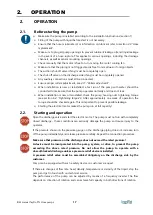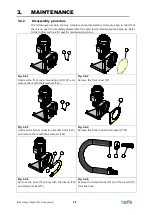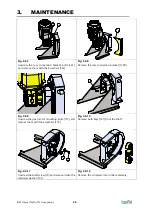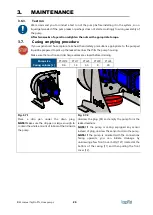
1. INSTALLATION
IOM manual Tapflo PTL Hose pumps
13
1.8.3.
Potentially explosive atmospheres
–
ATEX
The standard PTL series pumps are not allowed to operate in potentially explosive atmospheres.
Special PXTL pumps are available for such applications. Follow ATEX supplementary instructions
(see section 7) and local/national rules for safe use.
1.8.4.
Chemical hazard
Whenever the pump is to be used for pumping a different liquid, it is essential to clean the
pump beforehand in order to avoid any possible reaction between the two products.
1.8.5.
Noise level
Hose pumps, including the motor, in normal operating conditions produce a sound level below
70 dB(A). The major sources of noise are: liquid turbulence in the installation, cavitation or any
other abnormal operation that is independent from the pump construction nor the pump
manufacturer. The user must provide suitable protective means if the sources of noise could
produce a harmful noise level for operators and for the environment (in compliance with current
local regulations).
1.8.6.
Temperature hazards
➢
Raised temperature can cause damage on the pump and/or piping and may also be
hazardous for personnel in the vicinity of the pump/piping. Avoid quick temperature
changes and do not exceed the maximum temperature specified when the pump was
ordered. See also general max temperatures based on water in chapter
6.
“
Data
”.
➢
Ambient temperature limits are form -20
º
C to +40
º
C. When the pump is exposed to ambient
temperature variations or if there is big difference between the temperature of the product
and the surrounding, the tightening torques of the housing nuts should be checked
periodically as part of preventive maintenance (contact Tapflo for interval proposals).
➢
If a hot product is pumped, the pump should not stand still when filled for a longer period
of time. This could cause leakage from the pump.
➢
Below 0°C (32°F) plastic materials become more fragile what can cause accelerated wear of
parts made of these materials. This is a hazard that has to be accepted when pumping such
cold products. Also in such case, when a pump is not operational it should be drained of all
liquid.
➢
Bear in mind that the viscosity of the product changes with temperature. This has to be
taken into consideration when selecting the pump.
➢
The fluid remaining in the connected piping, as well as in the pump itself, may expand
because of freezing or heat, which may cause damage to the pump or/and piping, and lead
to leakage of the fluid.
➢
Some parts of the hose pump can become hot during operation and cause burns, therefore
make sure to use appropriate protection when handling the pump.
Summary of Contents for PTL Series
Page 63: ......





























